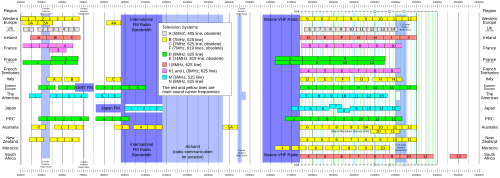Specifications
Some of the important specifications for System C are listed below: [4] [3] [1] [5]
- Frame rate: 25 Hz
- Interlace: 2/1
- Field rate: 50 Hz
- Lines/frame: 625
- Line rate: 15.625 kHz
- Visual bandwidth: 5 MHz
- Vision modulation: Positive
- Preemphasis: 50 μs
- Sound modulation: AM
- Sound offset: +5.5 MHz
- Channel bandwidth: 7 MHz
- Assumed display device gamma: 2.0

Television channels were arranged as follows: [2]
| Channel | Video carrier (MHz) | Audio carrier (MHz) |
|---|---|---|
| 1 | 41.25 | 46.75 |
| 1A | 42.25 | 47.75 |
| 2 | 48.25 | 53.75 |
| 2A | 49.75 | 55.25 |
| 3 | 55.25 | 60.75 |
| 4 | 62.25 | 67.75 |
| 4A | 82.25 | 87.75 |
| 5 | 175.25 | 180.75 |
| 6 | 182.25 | 187.75 |
| 7 | 189.25 | 194.75 |
| 8 | 196.25 | 201.75 |
| 9 | 203.25 | 208.75 |
| 10 | 210.25 | 215.75 |
| 11 | 217.25 | 222.75 |
| 12 | 224.25 | 229.75 |